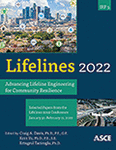Real-Life Investigations of Inverse Filtering for Frequency Identification of Bridges Using Smartphones in Passing Vehicles
Publication: Lifelines 2022
ABSTRACT
This paper puts forward a real-life assessment of a novel inverse filtering methodology to extract bridge features from acceleration signals recorded on smartphones in the passing vehicles. The vibration of a moving vehicle is affected by various features, such as suspension and speed. This study focuses on filtering out these effects from the signals to extract bridge frequencies as the vehicle crosses the bridge. Hence, the spectrum of the vibration data recorded on the vehicle when moving off the bridge is employed to form an inverse filter which removes the vehicle-related frequency content. Since the speed of the vehicle is found to be one of the most effective factors in the filter design in our previous studies, a database of the off-bridge vibrations is built for different speeds. Later, when the same vehicle is moving on the bridge, the corresponding inverse filter is applied to the recorded on-bridge data to suppress the vehicle frequencies and amplify the bridge frequencies. All the required data are recorded using the built-in accelerometer and GPS sensor of the smartphone, eliminating the need for any extra instruments. In addition, this approach considers each data source separately and designs a unique filter for each data collection device within each vehicle, which makes it robust against device and vehicle features. As a result of the proposed methodology, it would be possible to monitor a large number of bridges using crowdsourced data collected from the smartphones in the vehicles. Such methodologies are expected to improve the sustainability and resiliency of our future infrastructure systems and future cities.
Get full access to this article
View all available purchase options and get full access to this chapter.
REFERENCES
Bhoraskar, R., Vankadhara, N., Raman, B., and Kulkarni, P. (2012). “Wolverine: Traffic and road condition estimation using smartphone sensors.” 4th International Conference on Communication Systems and Networks, COMSNETS 2012, Bangalore, India, 3-7 Jan. 2012.
Cerda, F., Chen, S., Bielak, J., Garrett, J. H., Rizzo, P., and KovaČević, J. (2014). “Indirect structural health monitoring of a simplified laboratory-scale bridge model.” Smart Structures and Systems, 13(5), 849–868.
Guan, S., Bridge, J. A., Li, C., and DeMello, N. J. (2018). “Smart Radar Sensor Network for Bridge Displacement Monitoring.” Journal of Bridge Engineering, 24(1), 04018102.
Gul, M., and Catbas, F. N. (2011). “Structural health monitoring and damage assessment using a novel time series analysis methodology with sensor clustering.” Journal of Sound and Vibration, 330(6), 1196–1210.
Händel, P., Ohlsson, J., Ohlsson, M., Skog, I., and Nygren, E. (2014). “Smartphone-based measurement systems for road vehicle traffic monitoring and usage-based insurance.” IEEE Systems Journal, 8(4), 1238–1248.
Hsieh, K. H., Halling, M. W., and Barr, P. J. (2006). “Overview of Vibrational Structural Health Monitoring with Representative Case Studies.” Journal of Bridge Engineering, 11(6), 707–715.
Keenahan, J., OBrien, E. J., McGetrick, P. J., and Gonzalez, A. (2014). “The use of a dynamic truck-trailer drive-by system to monitor bridge damping.” Structural Health Monitoring, 13(2), 143–157.
Malekjafarian, A., McGetrick, P. J., and Obrien, E. J. (2015). “A review of indirect bridge monitoring using passing vehicles.” Shock and Vibration, 2015, 286139.
Matarazzo, T. J., Santi, P., Pakzad, S. N., Carter, K., Ratti, C., Moaveni, B., Osgood, C., and Jacob, N. (2018). “Crowdsensing Framework for Monitoring Bridge Vibrations Using Moving Smartphones.” Proceedings of the IEEE, 106(4), 577–593.
Mei, Q., and Gül, M. (2019). “A crowdsourcing-based methodology using smartphones for bridge health monitoring.” Structural Health Monitoring, 18(5–6), 1602–1619.
Mei, Q., Gül, M., and Boay, M. (2019). “Indirect health monitoring of bridges using Mel-frequency cepstral coefficients and principal component analysis.” Mechanical Systems and Signal Processing, Elsevier Ltd, 119, 523–546.
Mei, Q., Gül, M., and Shirzad-Ghaleroudkhani, N. (2020). “Towards smart cities: crowdsensing-based monitoring of transportation infrastructure using in-traffic vehicles.” Journal of Civil Structural Health Monitoring, 10(4), 653–665.
OBrien, E. J., Malekjafarian, A., and González, A. (2017). “Application of empirical mode decomposition to drive-by bridge damage detection.” European Journal of Mechanics, A/Solids, Elsevier Ltd, 61, 151–163.
Sattar, S., Li, S., and Chapman, M. (2018). “Road surface monitoring using smartphone sensors: A review.” Sensors, 18, 3845.
Shirzad-Ghaleroudkhani, N., and Gül, M. (2020). “Inverse Filtering for Frequency Identification of Bridges Using Smartphones in Passing Vehicles: Fundamental Developments and Laboratory Verifications.” Sensors, 20(4), 1190.
Shirzad-Ghaleroudkhani, N., Mei, Q., and Gül, M. (2020). “Frequency Identification of Bridges Using Smartphones on Vehicles with Variable Features.” Journal of Bridge Engineering, 25(7), 04020041.
Staacks, S., Hütz, S., Heinke, H., and Stampfer, C. (2018). “Advanced tools for smartphone-based experiments: Phyphox.” Physics Education, Institute of Physics Publishing, 53(4), 045009.
Yang, Y. B., Lin, C. W., and Yau, J. D. (2004). “Extracting bridge frequencies from the dynamic response of a passing vehicle.” Journal of Sound and Vibration, 272(3–5), 471–493.
Information & Authors
Information
Published In
History
Published online: Nov 16, 2022
Authors
Metrics & Citations
Metrics
Citations
Download citation
If you have the appropriate software installed, you can download article citation data to the citation manager of your choice. Simply select your manager software from the list below and click Download.
